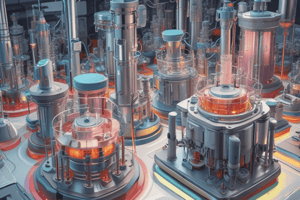Podcast
Questions and Answers
What is the primary function of the filament in the cathode of the x-ray tube?
What is the primary function of the filament in the cathode of the x-ray tube?
- To create a vacuum within the glass envelope
- To emit electrons when heated (correct)
- To focus the x-ray beam towards the anode
- To produce high voltage for x-ray generation
Which part of the x-ray tube serves to direct electrons towards a specific area on the anode?
Which part of the x-ray tube serves to direct electrons towards a specific area on the anode?
- The focusing cup (correct)
- The tube window
- The filament
- The glass envelope
What distinguishes the tube window from the rest of the glass envelope?
What distinguishes the tube window from the rest of the glass envelope?
- It contains the cathode and anode components
- It is coated with a special material to enhance x-ray output
- It allows for emission of x-rays while minimizing attenuation (correct)
- It is thicker than the other glass segments
In the context of an x-ray tube, which statement accurately describes the role of the cathode?
In the context of an x-ray tube, which statement accurately describes the role of the cathode?
Which of the following correctly identifies the components of the cathode in an x-ray tube?
Which of the following correctly identifies the components of the cathode in an x-ray tube?
What property of tungsten contributes to its unlikely burning out in applications similar to light bulbs?
What property of tungsten contributes to its unlikely burning out in applications similar to light bulbs?
What would happen if tungsten vaporized easily?
What would happen if tungsten vaporized easily?
Why is it significant that tungsten does not vaporize easily in a light bulb scenario?
Why is it significant that tungsten does not vaporize easily in a light bulb scenario?
Which of the following could happen if tungsten did vaporize easily?
Which of the following could happen if tungsten did vaporize easily?
What is a key characteristic of tungsten that makes it ideal for high-temperature applications?
What is a key characteristic of tungsten that makes it ideal for high-temperature applications?
What is the general size of the filament discussed?
What is the general size of the filament discussed?
How does the filament's design compare to those found in common household appliances?
How does the filament's design compare to those found in common household appliances?
Which property of the filament is specifically mentioned in its description?
Which property of the filament is specifically mentioned in its description?
What is the primary function of a filament in an appliance?
What is the primary function of a filament in an appliance?
In terms of physical dimensions, how does the described filament differ from a standard kitchen toaster filament?
In terms of physical dimensions, how does the described filament differ from a standard kitchen toaster filament?
What effect does reducing the target angle have on the effective focal spot size?
What effect does reducing the target angle have on the effective focal spot size?
What determines the value given when identifying small or large focal spots?
What determines the value given when identifying small or large focal spots?
In radiography, what is generally the relationship between focal spot size and image resolution?
In radiography, what is generally the relationship between focal spot size and image resolution?
Which statement about focal spots is incorrect?
Which statement about focal spots is incorrect?
What happens to the effective focal spot when an angle is made smaller?
What happens to the effective focal spot when an angle is made smaller?
What is the correct arrangement of filaments in bi-angle x-ray tubes?
What is the correct arrangement of filaments in bi-angle x-ray tubes?
Which of the following statements is true regarding the placement of filaments in bi-angle x-ray tubes?
Which of the following statements is true regarding the placement of filaments in bi-angle x-ray tubes?
Why must the small focus filament be placed above the large filament in bi-angle x-ray tubes?
Why must the small focus filament be placed above the large filament in bi-angle x-ray tubes?
In the design of bi-angle x-ray tubes, what is the significance of placing filaments end to end?
In the design of bi-angle x-ray tubes, what is the significance of placing filaments end to end?
What potential issue can arise if the filaments in bi-angle x-ray tubes are not arranged correctly?
What potential issue can arise if the filaments in bi-angle x-ray tubes are not arranged correctly?
Flashcards are hidden until you start studying
Study Notes
Tube Window
- A segment of glass thinner than the rest of the glass envelope
Cathode
- Negative side of the x-ray tube
- Composed of a filament and a focusing cup
- Filament is a coil of wire similar to a kitchen toaster but much smaller
- Filament is approximately 2 mm in diameter and 1 to 2 cm long
- Filament is made of tungsten which has a melting point of 3410°C, making it resistant to burning out
- Tungsten doesn't vaporize easily, preventing the tube from becoming gassy and coating internal parts
- Filaments in bi-angle x-ray tubes are placed "end to end" with the small focus filament above the large filament
- The focal spot size is determined by the target angle, a smaller target angle results in a smaller effective focal spot size
Studying That Suits You
Use AI to generate personalized quizzes and flashcards to suit your learning preferences.




